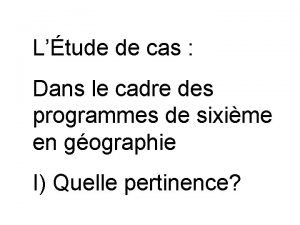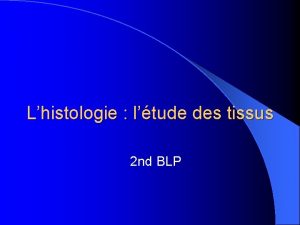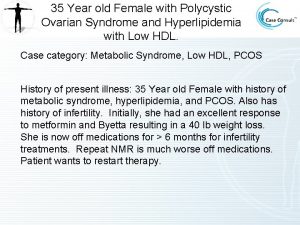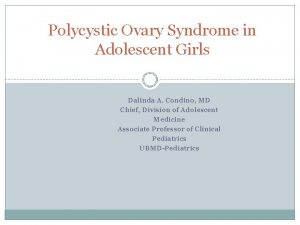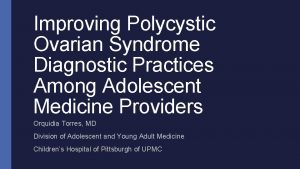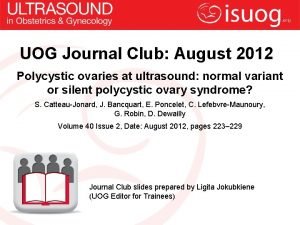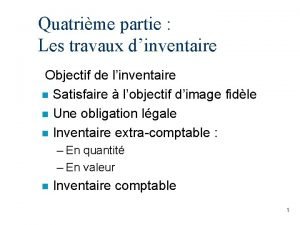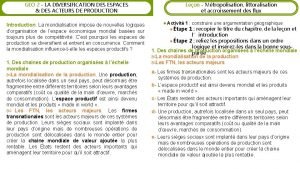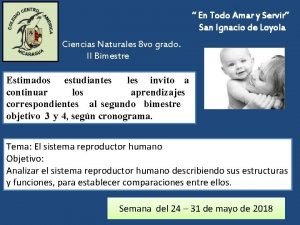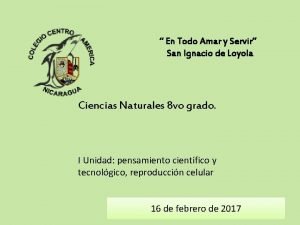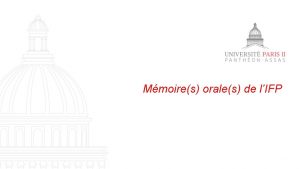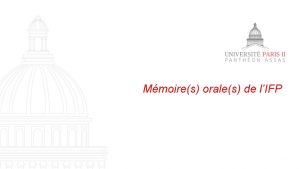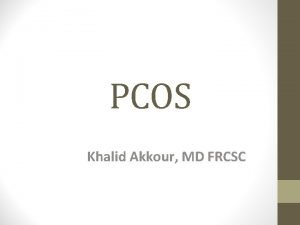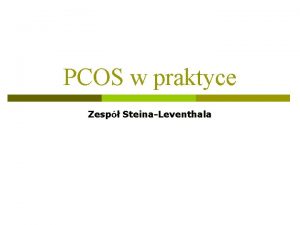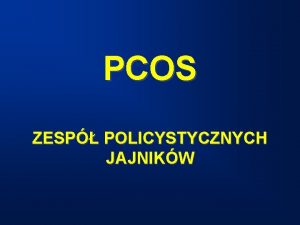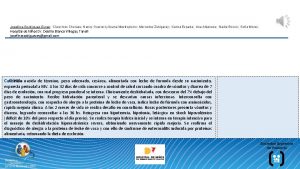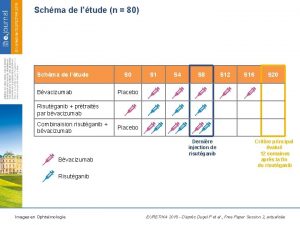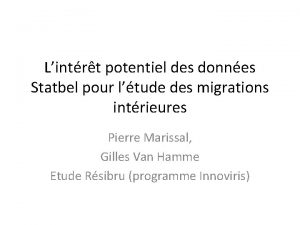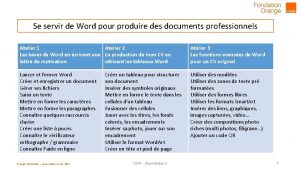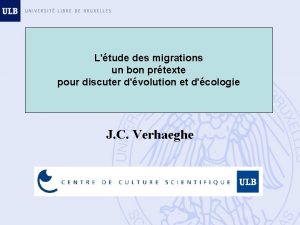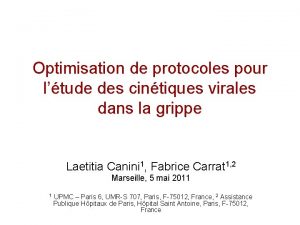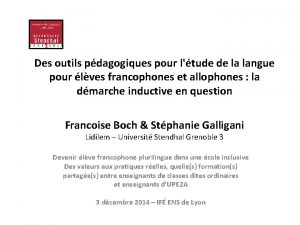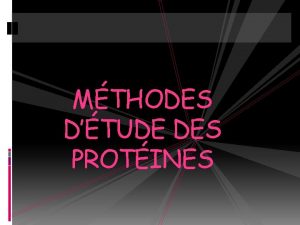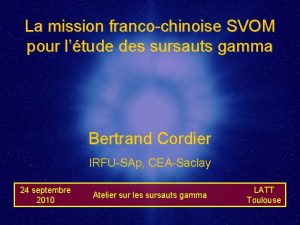PCOS Chereau A Mmoires pour servir ltude des
















































- Slides: 48


Σύνδρομο πολυκυστικών ωοθηκών (PCOS) οι πρώτες περιγραφές • Chereau A. Mémoires pour servir à l'étude des maladies des ovaires. Paris: Fortin, Masson & Cie. 1844. • Rokitansky C. A manual of pathological anatomy-Vol II. Philadelphia: Blanchard & Lea, 1855: 246 (tr. by Edward Sieveking from original German. edition of 1844).



















Androgen Excess and PCOS Society Criteria for the diagnosis of PCOS

Two significant issues cloud these deliberations. First, from a practical standpoint, inaccuracies in current assay systems do not allow for a clear cut diagnosis of androgen excess quite often in the absence of skin manifestations. Secondly, androgen excess may sometimes be cryptic and only manifest with ovarian stimulation, for example. Clearly, however, the presence of androgen excess makes most of the traditional features of PCOS(insulin resistance/overweight or obesity) worse or more severe. Thus in the absence of documented androgen excess, if PCOS exists it is mild and therefore subtle. In this setting, does the naming of the phenotype as PCOS matter? Does it affect treatment? More discussion on these points will be forthcoming. However, from a practical standpoint, while the majority of women with this phenotype (but not all) probably have a mild form of PCOS, itis not likely to affect management, at least while they maintain these features. However these patients should not be included in studies which attempt to define the genetics or pathophysiology of PCOS.










Genetic changes which resulted deletion or deficiency of 21 hydroxylase enzyme. Genetic change Mapping Phenotype Enzyme activity A or C G intron 2 Sv/sw minimal ( 1) deletion of pairs and bases exon 3 sw 0 Ile 172 Asn exon 4 sv 3 -7 Ile 236 Asn Val Clu 237 Clu exon 6 sw 0 Met 239 Lys Clu 292 Ser exon 7 sw 0 Arg 356 Trp exon 8 sv/sw 2 Pro 30 Leu exon 1 Nc/sv 30 -60 Val 281 Leu exon 7 Nc 20 -50 Pro 453 Ser exon 10 Nc 20 -50 sw: classical form with salt wasting; sv: simple virilizing form; Nc: non-classical form; cluster

EDITOR’S NOTE: This article is part of a series of continuing education activities in this Journal through which a total of 36 AMA/PRA Category 1 Credits. TM can be earned in 2009. Instructions for how CME credits can be earned appear on the last page of the Table of Contents. Congenital Adrenal Hyperplasia Because of 21 -Hydroxylase Deficiency A Genetic Disorder of Interest to Obstetricians and Gynecologists Eftihios Trakakis, MD, *† Constantine Loghis, MD, † and Demetrios Kassanos, MD† * Volume 64, Number 3 OBSTETRICAL AND GYNECOLOGICAL SURVEY Copyright © 2009 by Lippincott Williams & Wilkins













Unravelling the phenotypic map of polycystic ovary syndrome (PCOS): a prospective study of 634 women with PCOS. Evanthia Diamanti-Kandarakis and Dimitrios Panidis • Patients. Six hundred and thirty-four women with PCOS (18– 35 years) and comparable body mass index (BMI), diagnosed by ESHRE/ASRM criteria, were categorized into two major groups of phenotypes: classic (NIH) and non-classic (ESHRE/ASRM), and then subdivided into phenotypes with all possible combinations of diagnostic characteristics. One hundred and eight healthy women of reproductive age, matched for BMI, were recruited as the control group. • Measurements. Ultrasonographic (ovarian follicle number and volume), hormonal and metabolic parameters.

Unravelling the phenotypic map of polycystic ovary syndrome (PCOS): a prospective study of 634 women with PCOS. Evanthia Diamanti-Kandarakis and Dimitrios Panidis • Results. Classic PCOS phenotype was more frequent (85· 96%) than the non-classic phenotype (14· 04%). The patients were also classified according to the presence of biochemical (80· 60%) or clinical hyperandrogenaemia (12· 62%), and, in the newly introduced group, to absence of evidence of hyperandrogenaemia (6· 78%). Subjects with classic PCOS with biochemical hyperandrogenaemia (74· 76%) were more insulin resistant than controls. In women with PCOS, follicle number was positively related to both insulin resistance and biochemical hyperandrogenaemia. Additionally, women with PCOS had a 6· 58 -fold increased relative risk (RR) of > 12 follicles on intravaginal ultrasound a 2· 94 -fold increased RR of ovarian volume > 10 cm 3 compared to controls. • Conclusion. The most frequent PCOS phenotype is the subgroup with biochemical hyperandrogenaemia only within the classic phenotype, which is more insulin resistant than the control group. The follicle number, a newly introduced ultrasonographic marker, is related to both metabolic and hormonal features of PCOS.

1. The prevalence of non-classical congenital adrenal hyperplasia due to 21 -hydroxylase deficiency in Greek women with hirsutism and polycystic ovary syndrome Eftihios Trakakis , Demetrios Rizos, Costantine Loghis, Athanassios Chryssikopoulos, Marilyn Spyropoulou, Emannuel Salamalekis, George Simeonides, Vassilis Vagopoulos, George Salamalekis, Demetrios Kassanos. Endocrine J 2008 ; 55 : 32 -39 AE-PCOS Quarterly Literature Summary & Review May 2008 Bulent Yildiz, M. D. , Editor. In this issue, Dave Abbott, Kathy Hoeger and Francesco Orio have provided selected commentaries 2. Hemodynamic alterations and wall properties in large arteries of young, normotensive, and non-obese women with polycystic ovary syndrome E. Trakakis, A. Balanika, C. Baltas, C. Loghis, G. Simeonidis, V. Vaggopoulos, O. Papakonstantinou, A. Gouliamos, G. Salamalekis, and D. Kassanos. J Endocrinol Invest 2008 ; 31 : 1001 -1007 AE-PCOS Quarterly Literature Summary & Review November 2008. Steven R. Lindheim, M. D, M. M. M. , Editor
 Il existe des personnes qui sont des lumières pour tous
Il existe des personnes qui sont des lumières pour tous Ltude
Ltude Epithelium stratifié
Epithelium stratifié Ltude
Ltude Toi et moi basel
Toi et moi basel Is byetta used to treat pcos
Is byetta used to treat pcos Pcos ultrasound report
Pcos ultrasound report Ferriman-gallwey score
Ferriman-gallwey score Pcos macros
Pcos macros Normoz tablet use
Normoz tablet use Uog journal
Uog journal Des des des
Des des des Expressions avec le subjonctif
Expressions avec le subjonctif Transposer une phrase
Transposer une phrase Pour cet immense bonheur alléluia
Pour cet immense bonheur alléluia Des cartes pour comprendre le monde
Des cartes pour comprendre le monde Provision pour dépréciation des titres
Provision pour dépréciation des titres Pour toi maman henri des
Pour toi maman henri des Je sers un sauveur tendre
Je sers un sauveur tendre Des conseils pour la vie
Des conseils pour la vie Robin des bois des alpes
Robin des bois des alpes Mode verbaux
Mode verbaux Volume correspondant à une division
Volume correspondant à une division Des in network security
Des in network security Plan marshall affiche
Plan marshall affiche Cartographie des flux de valeur
Cartographie des flux de valeur Budget des ventes méthode des moindres carrés
Budget des ventes méthode des moindres carrés Diversification des espaces et des acteurs de la production
Diversification des espaces et des acteurs de la production Je t'offrirai des fleurs et des nappes en couleurs
Je t'offrirai des fleurs et des nappes en couleurs La diffusion des idées des lumières
La diffusion des idées des lumières Volume d un corps
Volume d un corps Si no vivimos para servir
Si no vivimos para servir Servir formal command
Servir formal command Advertência contra o servir de fiador
Advertência contra o servir de fiador Informe técnico nº 1819-2018-servir-gpgsc
Informe técnico nº 1819-2018-servir-gpgsc En todo amar y servir en latin
En todo amar y servir en latin No servir de fiador biblia
No servir de fiador biblia Commands in spanish tu
Commands in spanish tu Frases de san ignacio de loyola en todo amar y servir
Frases de san ignacio de loyola en todo amar y servir Ir y ser preterite
Ir y ser preterite En todo amar y servir
En todo amar y servir Prazer em servir
Prazer em servir Repetir stem change
Repetir stem change Buscad a dios mientras pueda ser hallado
Buscad a dios mientras pueda ser hallado Servir a dios y al dinero
Servir a dios y al dinero Formado para servir a dios
Formado para servir a dios Cuando yo andaba en el mundo
Cuando yo andaba en el mundo Significado de diaconisa
Significado de diaconisa Profase 1
Profase 1

